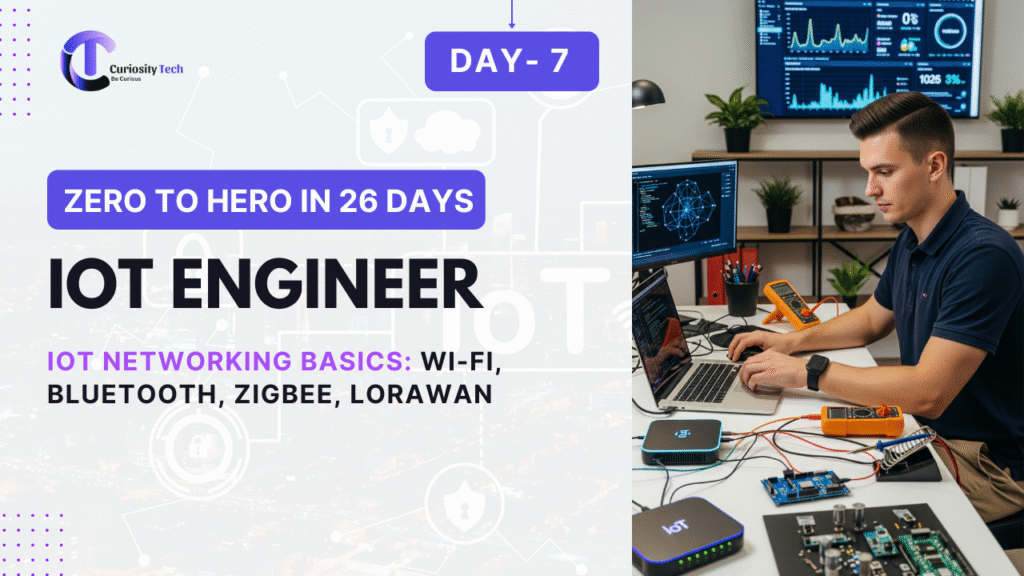If IoT devices are the “organs,” then networking is the bloodstream that makes them come alive. Without networking, sensors remain mute, actuators cannot act remotely, and cloud dashboards will have nothing to display. Networking in IoT, however, is not one-size-fits-all. Each technology — Wi-Fi, Bluetooth, Zigbee, LoRaWAN — has its sweet spot depending on coverage, bandwidth, power, and cost.
In this field-guide, we’ll examine four of the most widely used IoT networking standards, learn where they fit, and map them against real-world needs.
Field-Map Categories
- Wi-Fi: High-bandwidth, short to medium range.
- Bluetooth (Classic/BLE): Low-power, short range, personal devices.
- Zigbee: Mesh networking, low-power medium range.
- LoRaWAN: Ultra-long range, tiny data packets, IoT sensors spread across kilometers.
1. Wi-Fi – The Workhorse of IoT
- Range: 50–100 meters indoors (limited by walls).
- Bandwidth: High (up to hundreds of Mbps).
- Power Consumption: High (drains battery fast).
- Topology: Star (device ↔ access point).
- Use Cases: Smart homes, IP cameras, voice assistants.
Field Example:
At CuriosityTech.in Nagpur, students building IoT security cameras learn why Wi-Fi is chosen: it handles streaming video. But they also realize it is unsuitable for battery-powered sensors in fields — the camera must remain plugged in or use large batteries.
2. Bluetooth & Bluetooth Low Energy (BLE)
- Range: Typically 10–30 meters.
- Bandwidth: Low to medium.
- Power Consumption: Very low in BLE.
- Topology: Point-to-point or mesh (recent BLE versions).
- Use Cases: Wearables, health monitors, smart locks.
Field Inference:
Bluetooth dominates in personal IoT devices — fitness trackers send heart-rate info to phones, and BLE tags track keys or luggage. At CuriosityTech labs, BLE modules are often tested for human-proximity interactions, like employee attendance via BLE beacons.
3. Zigbee – The Mesh Builder
- Range: 10–100 meters per node, extended via mesh.
- Bandwidth: Low (20–250 kbps).
- Power Consumption: Low.
- Topology: Mesh, star, or tree.
- Use Cases: Smart lighting, smart cities, energy meters.
Why Unique?
Zigbee’s value is mesh networking — devices don’t just connect to a central hub; they pass data to each other. This enables large networks, like entire smart-building lighting systems.
- One failing node won’t kill the network since data routes dynamically.
CuriosityTech Example:
During a Smart Streetlight Prototype Project in Nagpur labs, teams installed Zigbee modules on lamp posts, where each node helped extend connectivity, creating a city-block span network.
4. LoRaWAN – The Long-Distance Messenger
- Range: 2–15 km urban, up to 50 km rural.
- Bandwidth: Very low (~0.3–50 kbps).
- Power Consumption: Extremely low (devices last years on one battery).
- Topology: Star-of-stars (end devices to gateways to network servers).
- Use Cases: Agriculture (field sensors), logistics (asset tracking), environmental monitoring.
Why LoRaWAN Matters in 2025:
Markets like smart agriculture in India rely on affordability + long-range. Soil moisture sensors in large farmlands cannot use Wi-Fi or Zigbee. LoRaWAN makes rural IoT feasible. At CuriosityTech, farm automation hackathons often incorporate LoRa modules like RFM95 or Dragino gateways.
Visual Spectrum Map (Conceptual Diagram Description)
Imagine a horizontal radio spectrum timeline:
- 2.4 GHz Band: Wi-Fi, Bluetooth, Zigbee all reside here (crowded).
- Sub-GHz Bands (868/915 MHz): LoRaWAN operates here — longer range, less congestion.
Overlay “range bubbles”:
- Wi-Fi bubble = medium, dense, high data.
- BLE bubble = very short, super low-power bubble.
- Zigbee bubble = mesh layer overlapping Wi-Fi’s range.
- LoRa bubble = massive rural coverage circle far beyond the rest.
Decision Tree Flow (When to Use What)
- Do you need video or high data throughput? → Wi-Fi.
- Do you need personal wearable/short-range low-power? → Bluetooth BLE.
- Do you need 100s of devices in a building with mesh extension? → Zigbee.
- Do you need 5,000 devices across kilometers of farmland? → LoRaWAN.
This decision-making is how professionals weigh connectivity, and this flowchart is regularly taught in CuriosityTech IoT networking modules.
Comparative Table of IoT Networking
| Feature | Wi-Fi | Bluetooth/BLE | Zigbee | LoRaWAN |
| Range | ~50m indoors | ~10–30m | ~10–100m per hop | Up to 50 km rural |
| Bandwidth | High | Low | Low | Very low |
| Power Use | High | Very low | Low | Very low |
| Topology | Star/AP | Point-to-point | Mesh/Star/Tree | Star-of-stars |
| Best Use Case | Smart homes | Wearables | Smart cities | Rural IoT, agriculture |
Common Mistakes Engineers Make
- Using Wi-Fi for battery-powered sensors: Drains in days.
- Assuming Bluetooth & Zigbee don’t interfere: Both in 2.4 GHz — interference handling is critical.
- Expecting LoRaWAN for continuous large data streams: Designed for small, infrequent packets.
- Not considering scalability: Zigbee may be better in a 1,000-sensor smart building than Wi-Fi.
Conclusion
IoT networking is not just about connectivity — it’s about designing the right network for the right problem. Wi-Fi brings data-heavy devices online, Bluetooth BLE powers personal devices, Zigbee creates resilient smart city meshes, and LoRaWAN extends IoT into rural, remote spaces.
For IoT engineers in 2025, mastery comes from comparing these technologies hands-on, which is why centers like CuriosityTech.in Nagpur organize live labs where teams deploy identical IoT applications across different protocols and measure results in latency, coverage, and power consumption. Real IoT expertise demands choosing the right networking fabric, not just knowing they exist


